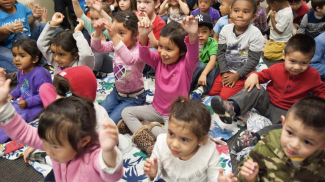
License Our Research Instruments
NIEER has developed a set of cost calculating tools, resources for using cost outputs, and briefs explaining the research behind the tools, and case studies of how they have been used. The Cost of Preschool Quality & Revenue (CPQ&R) tool is the complete tool that allows the user to modify assumptions. The State Administrative Cost of Quality budget planning tool helps users generate data on the functions and costs of the state infrastructure to implement, monitor, and sustain quality of early childhood programs. The Cost of Preschool Quality-Mini is a simplified version of the CPQ&R.

In March 2020, most preschool programs physically closed at the onset of the COVID-19 pandemic. For state-funded preschool programs, guidance differed in terms of what programs were required to provide to students. While some states mandated the provision of remote learning, others did not, and still others opted to provide alternative types of supports and resources to families (Friedman-Krauss et al., 2021).
This brief reports on the responses of district leaders in one state that offers state-funded preschool (New Jersey) on how they supported preschool learning at the onset of the COVID-19 pandemic.
Schools in New Jersey were closed to in-person instruction beginning March 18, 2020, and stayed closed for the remainder of the 2019-20 school year, requiring preschool programs to adapt instruction accordingly. The results highlight that while many children had access to or were encouraged to engage in activities like reading and music, participation rates varied critically, and the types of supports provided ranged in type, frequency, and duration. In addition, while close to two-thirds of districts provided professional development for teachers, much of this was centered on how to use the technology needed to reach children and families, rather than in developmentally appropriate practices or instructional strategies that could be used in the online environment. In addition, daily communication with children was absent in almost half of the districts, which means that remote learning occurred through a strong dependence on parents. While most districts rolled into the 2020-21 school year with more experience and preparation, looking back at the end of the 2019-20 school year provides an opportunity to reflect on lessons learned, on gaps in the opportunities provided, and on critical aspects to address moving forward.
Evaluating Supports for Dual Language Learners
In aliquam sem fringilla ut morbi. Mauris vitae ultricies leo integer malesuada nunc vel risus. Vitae elementum curabitur vitae nunc sed. Nisl nunc mi ipsum faucibus vitae aliquet nec. At tempor commodo ullamcorper a lacus vestibulum. Vel pharetra vel turpis nunc:
-
In aliquam sem fringilla ut morbi. Mauris vitae ultricies leo integer malesuada nunc vel risus. Vitae elementum curabitur vitae nunc sed. Nisl nunc mi ipsum faucibus vitae aliquet nec. At tempor commodo ullamcorper a lacus vestibulum. Vel pharetra vel turpis nun
-
Lorem ipsum dolor sit amet, consectetur adipiscing elit, sed do eiusmod tempor incididunt ut labore et dolore magna aliqua. Ut enim ad minim veniam, quis nostrud exercitation ullamco laboris nisi ut aliquip ex ea commodo consequat.
-
Lorem ipsum dolor sit amet, consectetur adipiscing elit, sed do eiusmod tempor incididunt ut labore et dolore magna aliqua. Ut enim ad minim veniam, quis nostrud exercitation ullamco laboris nisi ut aliquip ex ea commodo consequat. Duis aute irure dolor in reprehenderit in voluptate velit esse cillum dolore eu fugiat nulla pariatur. Excepteur sint occaecat cupidatat non proident, sunt in culpa qui officia deserunt mollit anim id est laborum.